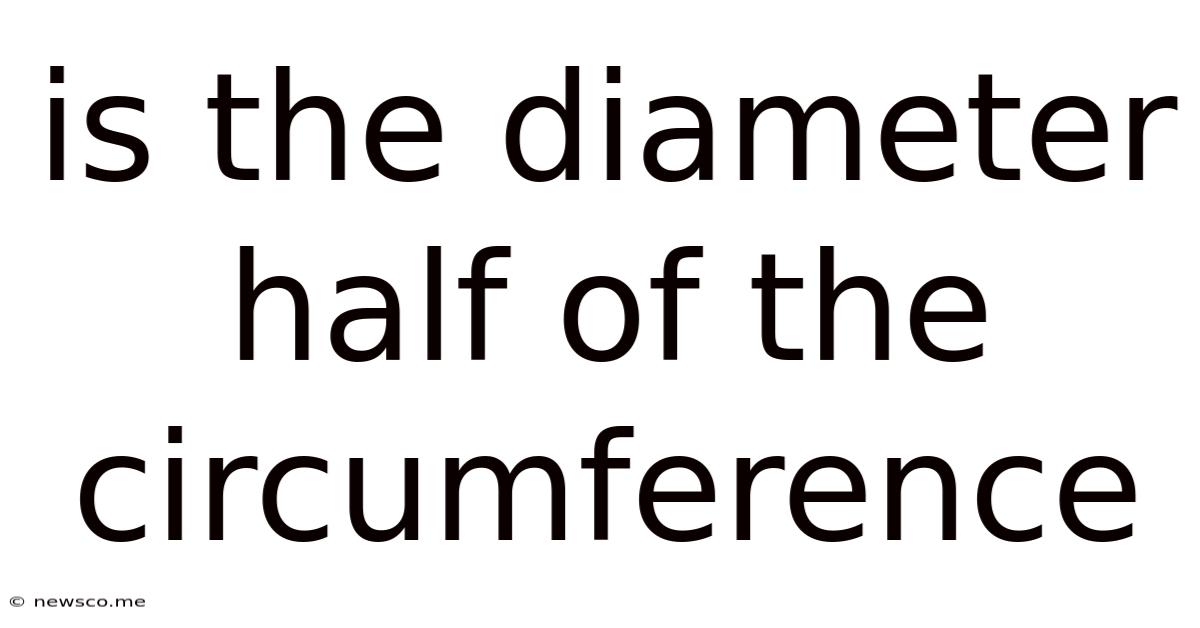Is The Diameter Half Of The Circumference
News Co
Apr 27, 2025 · 5 min read

Table of Contents
Is the Diameter Half of the Circumference? Unraveling the Relationship Between Diameter, Radius, and Circumference
The question, "Is the diameter half of the circumference?" is a common misconception stemming from a misunderstanding of fundamental geometric concepts. The short answer is a resounding no. The diameter and circumference of a circle are related, but not in a simple half-and-whole relationship. This article will delve into the precise relationship between these crucial circular measurements, exploring the mathematical formulas and clarifying the confusion surrounding this often-misinterpreted concept. We'll also examine the practical applications of understanding this relationship in various fields.
Understanding Key Terms: Diameter, Radius, and Circumference
Before we delve into the relationship, let's define our key terms:
-
Radius: The distance from the center of a circle to any point on its circumference. It's essentially half the diameter.
-
Diameter: The distance across a circle passing through the center. It's twice the radius.
-
Circumference: The distance around the circle. It's the perimeter of the circle.
The confusion often arises because the diameter is a straight line measurement across the circle, while the circumference is a curved line measurement around the circle. These are fundamentally different measurements, even though they are intrinsically linked.
The Fundamental Relationship: Pi (π)
The relationship between the diameter and the circumference of a circle involves a fundamental mathematical constant: Pi (π). Pi is an irrational number, approximately equal to 3.14159. It represents the ratio of a circle's circumference to its diameter. This means:
Circumference = π * Diameter
Or, expressed in terms of the radius (since Diameter = 2 * Radius):
Circumference = 2 * π * Radius
These formulas are foundational in geometry and are used extensively in various fields, from engineering to astronomy.
Why the Diameter is NOT Half the Circumference
The formulas clearly demonstrate that the circumference is not simply double the diameter; it's π times the diameter. Since π is approximately 3.14159, the circumference is roughly 3.14 times the diameter. Therefore, the diameter is approximately 1/3.14 or roughly 0.318 of the circumference.
The misconception might stem from a visual interpretation. Imagine trying to "straighten" the circumference into a line. Intuitively, one might think that this line would be roughly twice the length of the diameter. However, the curved nature of the circumference means that this simplification is inaccurate. The curved length is significantly longer than a straight line across the circle.
Practical Applications of Understanding the Relationship
The relationship between diameter, radius, and circumference is crucial in many practical applications:
1. Engineering and Design
-
Wheel Design: In designing wheels for vehicles or machinery, understanding circumference is vital for calculating speed, distance traveled, and gear ratios. The diameter directly influences the circumference, which in turn affects these crucial parameters.
-
Pipe Sizing: In plumbing and piping systems, the diameter determines the flow rate of liquids or gases. Knowing the circumference allows for accurate calculations of pipe surface area and volume.
-
Construction and Architecture: Circular structures like domes and towers require precise calculations involving the circumference and diameter for material estimation, stability analysis, and construction planning.
2. Astronomy and Astrophysics
-
Calculating Planetary Orbits: The circumference of a planet's orbit around a star is directly related to the diameter of the orbit. Understanding these relationships is fundamental to celestial mechanics and predicting planetary movements.
-
Analyzing Stellar Sizes: Astronomers use the apparent size of stars and their distances to estimate their diameters and thus, their circumferences.
3. Manufacturing and Production
-
Cutting and Shaping Materials: Manufacturing processes often involve creating circular parts. Accurate calculations of diameter and circumference are crucial for efficient material usage and precision cutting.
-
Packaging and Labeling: Circular containers require precise measurements of diameter and circumference for efficient packaging design and label placement.
4. Cartography and Geography
-
Mapping Circular Features: Maps often involve representing circular features like lakes or craters. Accurate calculations of diameter and circumference are important for representing these features accurately.
-
Calculating Earth's Circumference: Historically, the estimation of Earth's circumference was a significant achievement, relying on the fundamental relationship between diameter and circumference.
Dispelling the Misconception: Visual Aids and Analogies
To further clarify the relationship, let's use visual aids and analogies:
Imagine a circle with a diameter of 10 units. Its circumference would be approximately 31.4159 units (10 * π). Clearly, 31.4159 is not half of 10.
Another analogy involves a string wrapped around a circular object. The length of the string represents the circumference. If you straighten the string, you'll see that its length is significantly more than just twice the diameter of the object.
Advanced Concepts and Related Formulas
While the basic relationship is straightforward, more complex calculations involving circular segments and sectors require a deeper understanding of trigonometry and calculus. However, the fundamental relationship – Circumference = π * Diameter – remains the bedrock of these advanced calculations.
Conclusion: A Clear Understanding is Key
The relationship between the diameter and the circumference of a circle is not a simple half-and-whole relationship. The circumference is approximately 3.14 times the diameter, a factor determined by the constant π. Understanding this precise relationship is critical across numerous scientific, engineering, and mathematical disciplines. Hopefully, this detailed explanation has dispelled the common misconception and provided a clearer understanding of this fundamental geometric concept. By understanding the underlying principles, you can confidently approach problems involving circles and their various measurements. Remember the key formulas: Circumference = π * Diameter and Circumference = 2 * π * Radius, and you'll be well-equipped to tackle any challenges involving circular geometry.
Latest Posts
Related Post
Thank you for visiting our website which covers about Is The Diameter Half Of The Circumference . We hope the information provided has been useful to you. Feel free to contact us if you have any questions or need further assistance. See you next time and don't miss to bookmark.